THE EDGE
VOL. 15, ISSUE 2
ELON, NC

THE GAME OF CHANGE | EMBRACING DIVERSITY EXPLORING ANDROGYNY | HAPPY QUARTER LIFE CRISIS

VOL. 15, ISSUE 2
ELON, NC

THE GAME OF CHANGE | EMBRACING DIVERSITY EXPLORING ANDROGYNY | HAPPY QUARTER LIFE CRISIS

f you are reading this letter right now, that means you have, in your hands or laptop screen, the newest issue of The Edge Magazine ! To say it feels surreal to be writing the letter for this talented organization’s semester-long project would be a grand understatement. Looking back at this semester alone feels like a fever dream, the kind you never want to wake up from.
When former Editors-in-Chief, Sarah Hennis and Catie Mannato, emailed me to offer the position of editor, my first coherent thought was “Holy Sh*t.” At first, I was super excited! ‘This is awesome!’ I thought, ‘I’m the new head of The Edge!’ Immediately after that realization, came the thought “oh sh*t. I’m the new head”. I had already planned on taking an internship and several advanced classes for my junior spring semester, so doubts and fear of failing crept onto me faster than you can say “Imposter Syndrome”.
Despite my trepidation, I knew I couldn’t let go of this amazing opportunity. I had to take a step back and reframe my state of mind so that I could embrace this new change with an open mind and a positive attitude. ‘I was chosen to be EIC for a reason’,
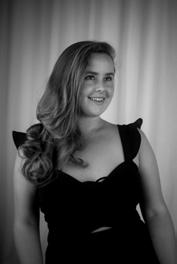
I told myself, ‘so I’m going to have confidence in myself to do this, the same way the previous EICs did’. This change of perspective, along with other instances of growth, led to the inspiration of this issue’s theme, Changing the Narrative.
Throughout recent years, our generation has experienced many instances of uncertainty and turmoil, such as a worldwide pandemic, devastating wars in the Middle East and controversial politics. It’s easy to feel overwhelmed and anxious about what’s to come next, particularly as we transition from childhood to young adulthood. This has led many to want to retreat back into the past, romanticizing simpler times when the world was less overwhelming and complex.
At the same time, our need to change persists, if not grows more, as we navigate our lives forward throughout college and beyond. This is the time where we learn and grow as individuals, to evolve our mindsets that embrace changes in our lives, however intimidating they may be. The universal desire for nostalgia and change is what drives us to create something that is both new and timeless for the world.
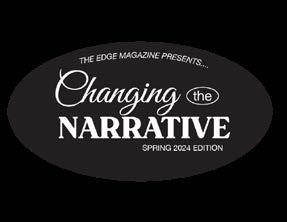

changing
the narrative balances the appeal of nostalgia and the need for change, bringing together a theme that is old and new, comforting and daring, diverse and universal.
This issue focuses on exploring others’ perspectives, taking new approaches to old ways of thinking and recreating traditions with a modern twist.
To all the team members, I want to give you the biggest thank you. The Edge has always been a community where creativity ran wild and ideas could be expressed so that there would never be any shortage of thought-provoking content. Having the privilege to see these talented minds work behind the scenes has given me a greater love and appreciation for this brilliant organization. This team has never failed to impress or awe me with their unwavering patience, enthusiastic energy and relentless creative talent. While transitioning into this position with a whole new team and executive board has been nerve-racking, having a strong foundation to support me has made it all the more rewarding.
This issue, not to mention this whole semester, would not have been possible without the amazing leadership of co-creative directors Ana Luisa Scholtes and Declan McGeady, executive copy chief Caden Halberg and executive managing director Leslie Aviles Mendoza. I couldn’t imagine spending my Friday afternoons at Schar Hall with anyone else, planning The Edge’s agenda for the next week. There are not enough words in the dictionary to express my gratitude for the dedication and support you have all given.
When reading this issue, I hope the insights and lessons provided help you learn, change and grow as a person, the same way it has done for me and many other members of The Edge. In order to reframe our perspectives, we have to be avant-garde, not be afraid of stepping outside the frame and be open to new experiences, all while paying homage to the timeless classics of the past. I’m beyond honored and proud to have led this team of talented creatives this past spring and I look forward to doing so again in the fall. So, without further ado, let’s start Changing the Narrative!
 Lexi Angermueller, Editor-in-Chief
Lexi Angermueller, Editor-in-Chief
Editor-in-Chief
Lexi Angermueller
Managing Director Leslie Aviles Mendoza
Creative Directors Ana Luisa Scholtes and Declan McGeady
Copy Chief Caden Halberg
Fashion
Editor Hannah Parker
Writer Caitlyn Bishop
Writer Sam Sutherland
Writer Ella Kucera
Writer Olivia Roederer
Writer Chloe Rawdon
Beauty & Wellness
Editor Riley Otis
Assistant Editor Emily Stabell
Writer Elizabeth Wiedboldt
Writer Natalie Conte
Writer Norah Kelleher
Lifestyle
Editor Abigail Hayes
Assistant Editor Isabel Steckman
Writer Alex Borda
Writer Kailey Casl
Writer Evie Wittmann
Writer Kayla Boyette
Travel
Editor Delaney Moore
Writer Emma Petrosino
Writer Eva Fragner
Writer Bella Frizzo
Writer Cailey Cetani
Writer Emily Cohn
Features
Editor Madi Rotermund
Assistant Editor Caroline Bentley
Writer Taylor Barbadora
Writer Hope Suire
Writer Madelyn Slattery
Writer Alexa Citrin
Writer Estella Hoye
Copy
Assistant Copy Chief Lyda Cosgrove
Assistant Copy Chief Jo Bogart
Videography
Director of Videography Kate Spencer
Video Assistant Sylvie Cullen
Video Assistant Alexandra Roever
Photography
Executive Assistant Julia Hardy
Executive Assistant Reese Garrity
Photographer Carina Kaplan
Photographer Jared Foutz
Photographer Dane Wetzel
Photographer Grace Goggin
Design
Designer Serafina Paratore
Designer Brianna Ward
Designer Chrissy Yeager
Designer Jenna Kate Gordon
Designer Sabrina Mannes Diaz de Ciero
Designer Clara Truebner
Designer Taylor Slow
Social Media
Social Media Director Gia Sylvester
Social Media Assistant Chloe Berkowitz-Pereyra
Social Media Assistant Chloe Schuster
Social Media Assistant Seldy Schiff
Digital Media
Analytics Director Caitlin Nay
Analytics Assistant Julia Smith
Analystics Assistant Lila Goldberg
Styling
Executive Stylist Sydney Perich
Makeup
Artist Minori Hata
Makeup Artist Aryanna Vindas
Finances
Finance Director Olivia Evans
The Race to Growing Up & Why We Need to Slow Down

6 12
Happy Quarter Life Crisis
Love Letter to my Teenage Years
16
Embracing Diversity
48
Family Ties & Unweaving the Knots
Rediscovering Comfort in Familiar Spaces

52
Exploring Androgyny
38
Are You Really Sorry?


58
Scrapbook Therapy
44
20 26 32
Life and the Lens
Sharing a Closet with Grandma
64
The Game of Change


Every day I cross off a little square of my calendar that represents my long lived day before. Every day I count down the weeks until Spring Break or Summer or Christmas. Every day, I look forward to going to bed just so that I can move onto the next. Every day, I’m in a race to grow up.
But I really need to slow down.
As a junior in college, swimming inside a strange mixture of childhood and real life, I am forced to confront the fact that I will fully be an adult soon. The moment I grab hold of my diploma and smile at the camera while shaking the hand of a person I don’t really know, I will be completing one of the final steps to growing up. I have looked forward to this moment my entire life — being older, independent and starting a new chapter of my life. Only now am I realizing what a big mistake I made by racing through life.

I’ve seen the toll social media has taken on children, especially young girls. No one is having playdates anymore. Instead, their mothers take them to the mall to stock up on Drunk Elephant and Dior lip oil. Kids, college students and young people alike are living in the age of influencers, the period of “get ready with me” videos and “legging legs.” Young adults are planning their internships for the next two summers and crafting what their future will look like in the next ten years. We are all planning how to get ahead of everyone else, whether that’s having the latest lip gloss or securing a six-figure post-grad paying job during your sophomore year of university.
I’ve noticed the way this race has impacted people like me. A lot of people my age are reverting to child-like trends. For example, I have a pile of stuffed animals I’ve accumulated sitting on my bed. My friends and I want to build sandcastles and boogie board on the beach. God, I would give anything to swing on the old, rusting tire


swing of my elementary school right now. I feel a deep rooted desire to relive my glory days — the time before life became a race to some unmarked finish line.
Many of us growing up also lived through the COVID19 Pandemic. To add even more salt to the wound, formative years of our lives, years that were supposed to tell us about ourselves and unlock our potential and passion, were spent locked indoors. Alone and isolated, we used social media to entertain us and that’s been our downfall.
What are we racing to in the end? Happiness? Success? Death? Do we always look for something in the future to distract us from day to day struggles? I think so. I plan for the future to help me get through the day. I say “Okay, well, maybe college isn’t my thing but I am going to thrive during post-grad.” I did the same in high school about college. We plan ahead so we don’t have to face the fact that as each day passes we are getting older and further away from the passionate, excited little kids we were so many years ago. I want to live a life again where my biggest worry was ice cream melting too fast from my cone, its sticky contents running down my hands and snaking its way through my fingers. I cannot go back in time, but I can change how I am living life now.



If we want to look back at our lives with appreciation instead of regret, we must learn to live in the moment. I know how repetitive that phrase is, but it’s the truth. We have to constantly be present and constantly apprecia tive of our ability to laugh and love and live.


Y o u w i l Y o u w i l Y o u w i l f i n d l o v e .


I want to look back at my life and have my eyes fill with the joy, wonder and enjoyment I felt during each moment I lived. I do not want to look back and only see how I was planning my next course of action. Right now, I want to start living like that little girl was living 10 years ago. Before the stress of love, before the stress of homework, before the stress of the race of life. I will no longer participate in this race to grow up.
 MODELS | MICHELLE DEROSE, NICOLE ANDRADE, ANABELLA PARISI, CALEB MARTIN, STEVEN MMARI
MODELS | MICHELLE DEROSE, NICOLE ANDRADE, ANABELLA PARISI, CALEB MARTIN, STEVEN MMARI
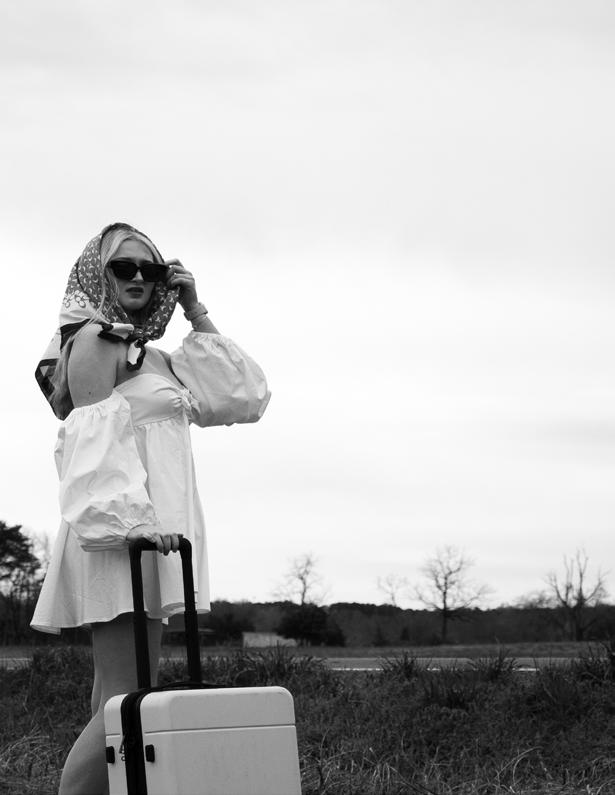
Because this is a celebration, really... we promise.
Car·pe Di·em, an exclamation – used to persuade someone to make the most out of the present moment, time or situation and give little thought to what comes next; most commonly translated to: Seize the Day.
Hey, we get it, change is scary. Change is gross. Change can make us feel completely debilitated. Change, plain and simple, sucks, and nothing is a bigger change than graduating college…or at least nothing yet.
‘The early twenties’ – a period categorized by someone ages 20-24 – is simultaneously the best, most liberating time of young adult life and the absolute worst, most uncomfortable. The early postgrad years are frequently seen as the most prominent time of immense highs and monumental lows; a trying time of heartbreak and growth, opportunity and rejection, rebranding and

refreshing. This era of life can be so intense that it has its own very special dilemma, move aside mid-life crisis and enter a new and improved punchy predicament –The Quarter-Life Crisis. The quarter-life crisis is classified as the periods of uncertainty and anxiety that arise when young adults start to question their goals, direction, future, quality of life, and purpose – how fun! We’re happy to say this provoking time can last into the mid to late twenties and, in some cases, into the early thirties, it can be as long as you’d like. How long you celebrate and soak in the upheaval is really up to you. In all seriousness, the mental gymnastics that the quarter-life crisis causes can be enough to place hermit mode on permanent, but, hear us out…what if graduating college and entering the postgrad era is something we looked forward to instead of mentally blocked away? What if we looked at this chapter as something to relish instead of dread? What if we treated quarter-life like it is – a true, celebratory milestone? Sure, we celebrate graduation but what about the day after? What about the year after? A milestone doesn’t just have to be a moment or day nor does it have to be physical, it can be an entire era or a new state of mind. A milestone should be shouted from the
rooftops and something to take pride in, so we urge you — seize this moment. If you’re asking yourself how to accept this new era of life you’re entering and how to let yourself succumb to the crisis in celebration…we’ve got you covered, babe. It’s time to shout ‘Carpe Diem!’ and seize the goddamn day.
If you think you may be experiencing symptoms of a quarter-life crisis, how exciting! Read on to find out the best way to celebrate this new chapter.
“Queue the sweet, sweet sounds of a harmonica.” If you’re feeling down about saying goodbye to the college version of you that you’ve come to know and can’t quite shake the melancholy, you may be experiencing a little-known symptom of the quarter-life crisis known as the ‘post-grad blues.’ The post-grad blues is classified as the time following graduation when a person might be struggling to cope with change, dealing with feelings of apathy, or over-intellectualizing past events to the point of anxiety. It’s

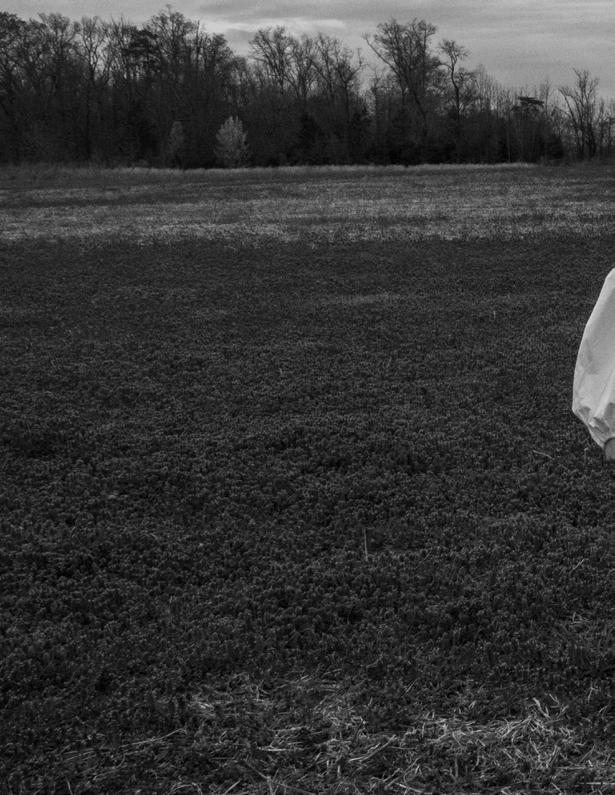
a time when acceptance might not be coming so easily and living in the past may seem inviting. But, hey, that’s okay! Yearning for the past is ohˆ-soˆ-romanticism-coded. Take these new cool-toned feelings as a sign to devote some time to self-love. Celebrate yourself. Maybe go on a little trip or take a social media detox. Remember to be gentle with your mind and let yourself have a nice cry if that’s what you need, we’ve all been there. Coping with the blues is a lengthy journey but it’s also something so universal, there’s not a whole genre of music dedicated to it for nothing, right? If you’re feeling blue we suggest putting on some Billie Holiday or Eilish, grabbing an iced bev, and going on a hot girl mental health walk with a lil’ pep in your step…maybe even bring balloons.
Let’s get one thing straight, as much as we feel the urge to be doing something at every moment, we really don’t have to. ‘FOMO’ or ‘Fear of Missing Out’ has become the new norm in our generation and is one of the most commonly experienced symptoms of quarter-life. According to Verywell Mind, FOMO refers to the feeling or perception that others are having more fun, living better lives, and experiencing more happiness. What a drag! According to PsychCental, “The innate desire for social connection and belonging can drive FOMO. It’s natural for humans to feel a need for interpersonal relationships and want to belong to something greater than themselves. When people feel they lack these types of connections, it can cause emotional and physical distress.” So, let it be known that this crummy feeling is natural. Perhaps it’s time to embrace the FOMO instead of letting it take up your brain power. To conquer the fear of missing out, it’s time for a major reframe and that starts with acceptance. Comparison is the thief of joy,
you know. To get over your FOMO, PsychCentral suggests remedies like journaling, meditation, getting in more quality time with those you might be missing, and doing an essential digital detox. Instead of obsessing over what you’re not doing, enjoy what you are doing. This time of your life is all about rediscovery which can bring discomfort, remember that and let it be yours to control.
Pack up your things, say your goodbyes and hop on that plane – because it’s time to move on to greener pastures. Bon Voyage, love. The quarter-life is the time to live by the no-regrets mentality and step out of your comfort zone because, frankly, the comfort zone isn’t serving this new era of you. While it may be enticing and familiar, the comfort zone just doesn’t allow for growth, it doesn’t welcome change. Change is persistent. Change is inviting. We’re all just hitchhiking through this unknown, trying to take every opportunity that comes our way and not crumple when we see others succeed. Success isn’t measured in dollars or jobs, it’s measured in experience and joy. So, consider making the move abroad. This is the perfect time to take a leap of faith across the pond and start anew. Traveling is a reset. Instead of focusing on a chapter ending, get excited for the one beginning. There are so many programs available to recent grads to help with this new transition and if seeing the world is what you seek, there are options. Maybe service is your passion, think about getting involved with the Peace Corps. From gap year programs to scholarship opportunities to teaching, going abroad after graduation can help you find yourself sans the backdrop of Elon’s campus. Feed your explorer syndrome, and take the chance. Get started on the bucket list now, why wait?

Seniors — listen up. You don’t have to see your future ahead. You don’t have to know where you’re going. Four years ago, the affectionate senior motto might have been, ‘2020 vision’, but, due to unpredictable life events, look how wrong that turned out to be. We all couldn’t quite see ahead, could we? Change is inevitable. Life will always move. Senior spring four years ago looked a lot different than it does now, and we say the 2020 vision is unnecessary. In fact, it’s overrated. Celebrate the unknown and live in the present, it’s all we have. Embrace this grad season with your whole heart just like you’re embracing quarter-life. The quarter-life is the era of you. The crisis is yours to command. These are our years. You’re only young once, right? Why waste all that time running away from a little self-reflection. The plane is yours to catch.



Growing up, it can seem like you are living in an echo chamber. Yes, there may be a dissension to a niche view you have, but for the most part, you are surrounded by those who have similar beliefs to you.
University can be seen as the time when our perspectives are challenged and beliefs are adjusted. Depending on the school you go to, this can result in large or small shifts in perspective. Whichever it may be, the chance to either solidify your perspective or modify it is presented while in university.
Junior Jackson Fender comes from Asheville, N.C., and grew up in a conservative, white, Christian community. With his high school years being dominated by political tension over COVID-19 and being isolated for months, Elon became a challenger to the perspectives he gained during that intense time.
“I’ve been forced to reflect on myself and reflect on my beliefs and kind of metamorphize into the type of person that I want to be,” Fender said.
Political views have to be one of the most prominent perspectives that can be challenged while in university. You may come in identifying as Republican, but come out as a moderate Democrat or maybe the other way around.
Others may have their perspectives solidified like Emily Fenimore, who is from Wilmington, Del. She says that coming from a politically participatory family and community to Elon, where political discussion is not as prevalent, has only strengthened her perspective more.
“I do not think that Elon gives me as wellrounded of a platform to discuss politics as I had in high school,” Fenimore said. “At Elon, I have found that students would rather be ignorant to the realities of our political climate.”



differ from what he believed when he first got to university.
“I feel like it really has helped me shape and figure out my political identity and what I believe in, compared to what resources that I had in high school and the type of experiences that I had back then.”
The turbulent time we live in can be a huge factor in influencing perspectives. The Israel-Hamas war has brought many to question their beliefs and the community they surround themselves with.
Senior Samantha Katz, who hails from Hopedale, M.A., grew up Jewish and is active in Chabad and Hillel. When the conflict first happened, she was shocked to see those she was close to in the community’s perspective on the issue.
“I lived in a very small bubble,” Katz said. “I thought everyone was okay with being Jewish when I first came to the school. I thought everything was fine. But this past fall, my eyes had been very much opened.”
However, not all experiences regarding interactions with faith are like Katz’s. Fender, as a part of his journey in
developing his perspective, surrounded himself with people from all different backgrounds and faiths. This process helped him while he was grappling with his personal view on religion.
“I feel like I have a really fragmented and turbulent relationship with religion just based on my lived experiences,” Fender said. “And to see people who maybe necessarily didn’t grow up with the same religion that I did, but still have positive experiences and it’s a huge part of their lives, is definitely an interesting perspective to gain.”
Friends and classmates are a great vehicle for perspectives to be influenced. Before coming to university, Fenimore never considered monetary status as a deciding factor for who she hung out with or how she treated people. However, since being at Elon, a private liberal arts school, she has witnessed first-hand with others how money can be everything when they are making friends.
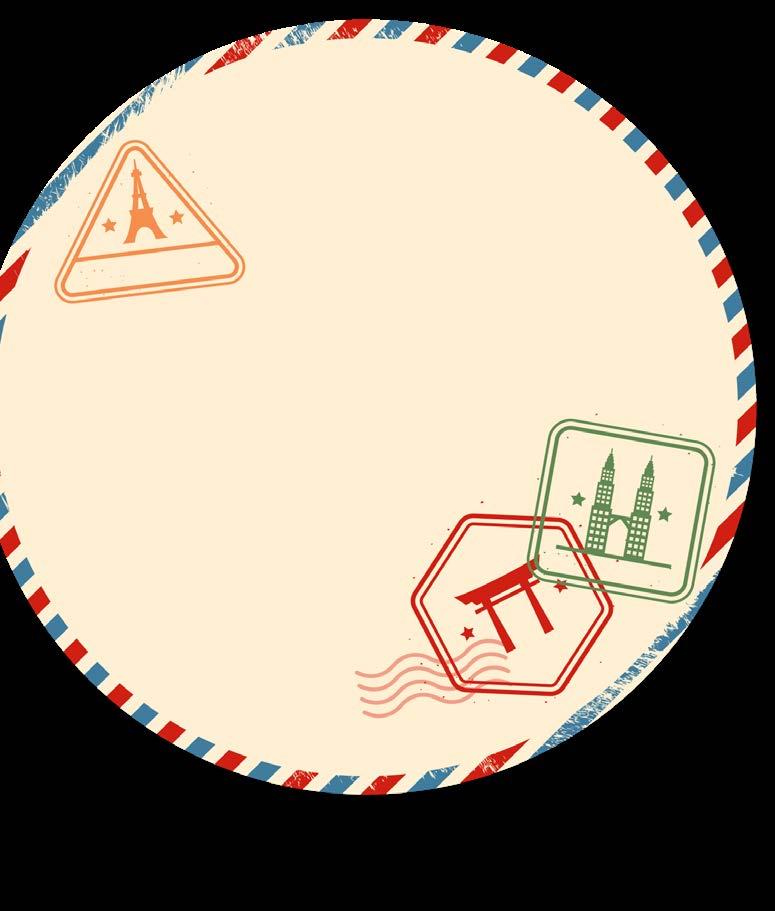

“There is a level of respect that one gains if they have money,” Fenimore said. “This is something that cannot be accomplished by the content of your character.”
Along the lines of social interactions, Fender experienced what he has called a “metamorphosis,” when it comes to interacting with and seeking out others. Coming out of high school, he was very against interacting with those who disagreed with him and “villainized them,” but now since coming to university, he has embraced multiple different perspectives in full force.
“That wasn’t a healthy way for me to live,” Fender said.“…But over the last three years, I feel like I’ve changed the way that I view that sort of interaction from trying to villainize somebody, to like: ‘I haven’t thought about it that way before.’ Because everybody has their own lived experiences and their own set of

circumstances that define how they operate on a day-to-day basis.”
Perspectives do not transform over a short period of time. It takes events, interactions and reflection to gain a new puzzle piece in your quest to understand the world and yourself. Without the quest and curiosity to educate yourself and gain new perspectives, there would be no diversity in thinking processes, and wouldn’t that be a dull way to live?.
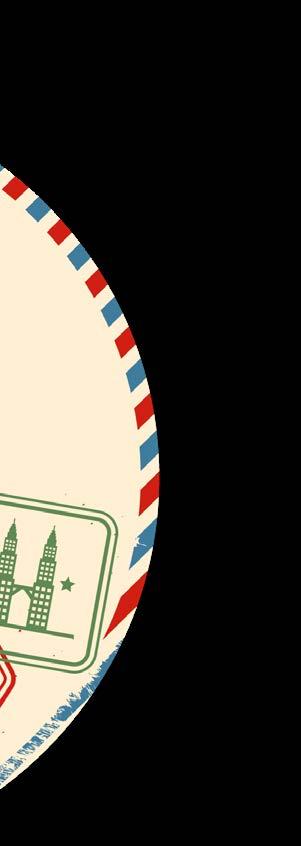







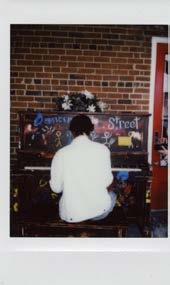
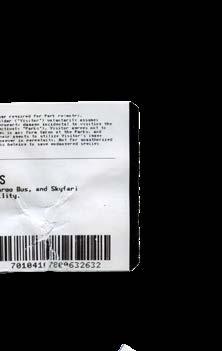



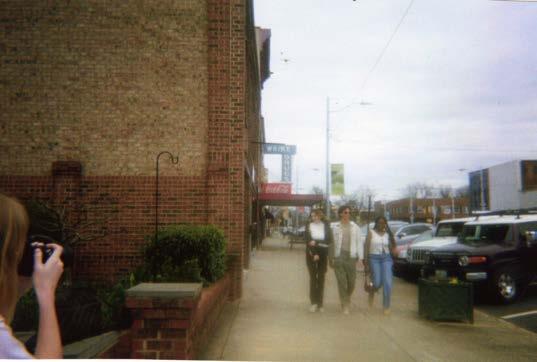

Iing thousands of moments frozen in pixels. Long gone are the days when each click of the camera shutter demanded intention and consideration. The smartphone camera has ushered in an era where every passing second can be captured with a simple tap. Yet, as we navigate this sea of snapshots, it’s worth reflecting on the trans formative journey of photography, tracing its roots to of film, which made it possible to shoot multiple pictures


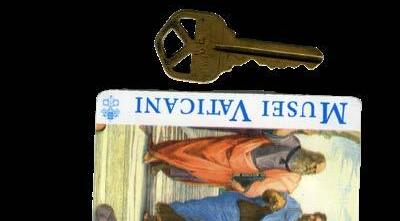






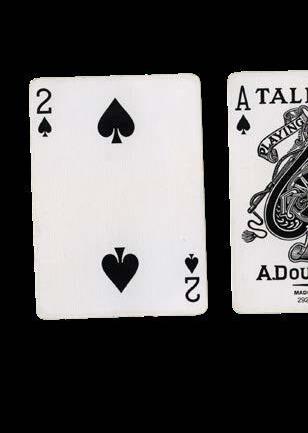








needed to be immediately and individually processed. The development of digital imaging technology in the latter half of the 20th century transformed photography. The first digital camera, the Kodak DCS, was introduced in 1991 paving the way for the digital photography era. Fast forward to the present day. The smartphone has become an extension of our beings with powerful cameras that fit neatly into our pockets. The immediacy of smartphone photography has undeniably altered the way we perceive, capture, and relive moments. In a society where the phrase “say cheese” has been replaced by quick taps on a touchscreen, the art of memory-making has evolved.
The smartphone camera not only captures moments but also shapes our perception of them. The instantaneous nature of smartphone photography can diminish the significance of an event, as we focus on recording the moment rather than fully experiencing it. The pressure to document every aspect of our lives for social media has created a culture where the act of living is intertwined with the act of capturing.
With that, the sheer volume of photos stored on our devices raises questions about the nature of memory itself. With thousands of images at our fingertips, the process of recalling specific moments becomes both effortless and overwhelming. Scrolling through a camera roll to find a particular photo turns memory into a visual journey, blurring the lines between the experience and its digital representation.
Scientists have begun to question the influence of smartphone photo taking on our memory. According to Psychology writer Brian Resnick in an article for Vice News, scientists are finding that constant photo-taking diminishes our ability to recall our experiences, divers our attention, and takes us out of the moment. The brain stores long-term memories by linking neurons. The stronger the memory, the stronger the connections. These neural links integrate various sensory inputs associated with memory, including visual, tactile, and olfactory sensations. However, if we fail to focus our attention or do not encode information into our shortterm memory, nothing will be consolidated into long-term memory storage in our brains.
Seeped into the Generation Z resurgence of old trends from Levi’s mom jeans to 80’s tracksuits is the film camera. Gen Z is attracted to the delayed gratification that the film camera provides and the filtered hue of a film photo. Disposable camera apps and the embrace of film cameras suggest a desire for a more intentional, curated approach to memory-making. In a world flooded
with digital images, the nostalgic appeal of film and disposable cameras transports back to a time when each click demanded consideration and every photo was a tangible keepsake.
This shift raises questions about the psychological impact of our digital era on memory and the value we place on our captured moments. Are we sacrificing the depth of experience for the breadth of documentation? As we navigate this sea of pixels, there seems to be a growing awareness of the need to reclaim a sense of intentionality in our memory-making practices.
The evolution of photography from the Brownie to the smartphone camera reflects technological advancements and a profound societal and psychological shift. The ease of smartphone cameras has democratized the art of capturing moments, but it also challenges us to reevaluate the way we perceive, experience, and remember those moments. As we embrace the digital age, there is a simultaneous longing for the intentional, mindful approach to memory-making embodied by the simplicity of the Brownie camera—a desire to balance the immediacy of the present with the depth of meaningful recollection.

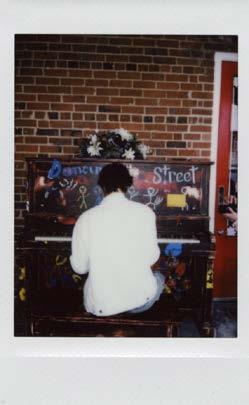
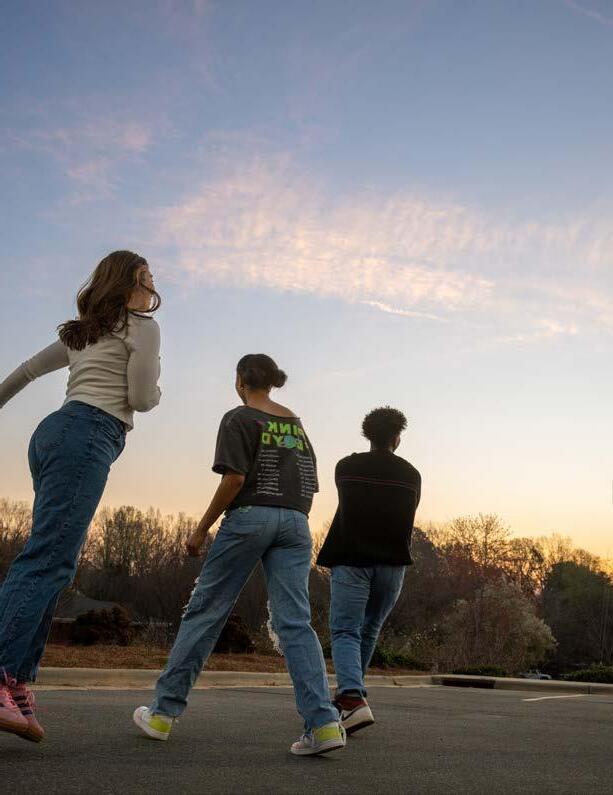






As I approach a new chapter in life, I struggle to process this transition from college to post-grad. Yet, as a means for closure, I thought the best way to reflect was to write a love letter to teenage Alex.
It’s a common sentence floating around college houses filled with angsty seniors. As we approach a new transition in life – one that may feel confusing, exciting, or even scary – it’s hard to grapple with the complexities of entering adulthood. After experiencing four years of living with your best friends and the highs and lows of college life together, you soon realize that this isn’t forever. The friendships you’ve made, memories that fit onto a tiny digital camera and personal growth throughout these years — that’s forever. Yet, the five-minute walk to your friends dorm, the last minute run for ice cream or bumping into someone you know around every corner… that’s coming to a close. As a new decade approaches, one cannot help but mourn the one before. As a means of closure for this crucial chapter in life, the best way to handle a mix of emotions is to take a moment to breathe. Reflect on the years that got you to this point, and cherish the fact that you can always look back on it.






When I turned thirteen years old, I felt on top of the world. I could finally say I was a teenager, and I felt pure excitement for all that was to come. I could go to PG-13 movies with my friends, my mom bought me my first real bra and the only stress I had was that fact that Zayn had left One Direction. Without realizing it, parts of the world around me were rapidly changing. TV streaming suddenly took over, social media began to play a larger role in my life (especially with the whole ‘is it black and blue or white and gold?’ dress debate) and more women started to fill roles on the screen. As you enter your

teenage years, friendships and social dynamics change, but at the ripe age of thirteen anything seemed possible. I hope to carry the excitement and hope I felt at this age into every year as I get older. Revisiting the interests of younger you can provide a feeling of nostalgia, a feeling that can reaffirm our current passions and goals. Whether that means listening to Taylor Swift’s “1989” album or reflecting on the awkward phase between 7th and 8th grade — thirteen, you made me feel eager to experience what was to come.
Let’s flash-forward two years later and the start of what I thought was the most terrifying thing: high school. Freshman year of high school is one of the most intimidating and tough transitions thus far.From being the oldest in middle school to the fresh meat in high school, my world suddenly expanded into a whole new universe. I had to navigate a new campus, new routines and new emotions. Converse, oversized t-shirts and Nike shorts were staple pieces. From these types of fashion trends to crushes and more, life started to revolve around who I hung out with. At fifteen, navigating friend groups felt

like the most important, life-changing situations. The social pressure to look a certain way or even act a certain way was a never-ending thought during this year. Since then, I’ve learned that it isn’t important to be a part of the latest fashion trends or to be in the “right” crowd. Fifteen was a year of transition that felt uncomfortable at the time, but looking back now I appreciate that feeling. You can only grow if you’re willing to embrace the discomfort that comes with change.
PHOTO | REESE GARRITY DESIGN | BRIANNA WARDBoys. Rumors. Parties. I thought these three words would define my time as being a sixteen year old. My friends were getting their licenses, having Sweet 16 parties and starting to think that maybe the boy who sat next to us in class wasn’t so weird. My mom taught me how to drive right before I got my license at this age. We drove down the road past our neighborhood, her right hand tightly gripping the “oh shit” handle. Even though I was going at least 20 under the speed limit, I tasted a new sense of freedom. I was now able to drive my friends and I to our local Sonic to grab a medium cherry slushee with extra nerds. I could drive to and from school, and gone were the texts to my friends: “my mom can pick us up if yours drops us off.” But, with this new-found freedom came new found insecurities. Similar to my friends, I started to notice every detail on my body which eventually led to a lot of self-criticism. My body had physically changed a lot in comparison to my thirteen-year-old self, and I was adjusting to new curves in areas I wasn’t used to. Yet, as I continued to develop physically and emotionally at sixteen, looking back now at this awkward stage that every teenager goes through feels rewarding. Even now, I hold insecurities about myself; but, I have learned to appreciate the small details. I have grown to learn how to love myself and discover healthy outlets to moments of self-doubt. Without sixteen, my teenage years wouldn’t have impacted me as significantly as they do now.
The four years of high school I spent taking AP classes, participating in extracurriculars and running for various leadership positions all led to where I wanted to attend college. Senior year of high school was a time where I felt the need to figure out exactly who I was and what I wanted to be. The pressure of attending college or entering the workforce right out of school were constant thoughts that filled the minds of my friends and I. Although we were focused on trying to figure out a plan, we also were focused on holding onto our friendships and relationships. Eighteen brought me my first heartbreak, or at least what I thought a heartbreak was at this age. Puppy love is a feeling we all have experienced at least once during our teenage years, but when it comes to an end we think it’s the worst thing we have ever felt at the time.



But, I soon realized that those heartbreaks won’t even be a thought four years later. Yet, most importantly, when I turned eighteen, I started discovering my real interests, whether that was hobbies such as writing or developing my music taste. A sudden mental shift occurred, and my friends and I were not only learning with each other, but from each other. I learned to appreciate the small things, because anything can disappear in the blink of an eye. With the transition from high school to college, eighteen made me feel more comfortable within myself. I was able to prioritize my goals, and eventually I moved from my small hometown to my new college town. Here, eighteen allowed me to further learn more about myself and work toward my idea of what brings genuine happiness.

The lessons I have learned during my teenage years helped me progress to where I am now – a senior in college with a few weeks left before graduation. Upon reflection, I’ve discovered that the struggles I face, the growth I experience, and the bonds I created during these years will forever be a part of me. As much as I wish I could freeze time, I would not value as much as I do now without my years as a teenager. Living through the awkward puberty stage, young love and friendships, I have learned so much about myself. I won’t sit here and tell you that I have everything figured out, because that’s when my twenties are for. But, I will tell you that as I enter this new stage in life, I have my teenage years to reflect on and appreciate. They do say you never quite let go of what you loved in your teens.
P.S. Twenties treat me well, please.

In the labyrinth of life’s complexities and challenges, amidst the rush of adulthood responsibilities, a sanctuary exists that transcends time and turmoil—the familiar spaces of our past. From the humble confines of childhood pillow forts to the enchanting realms discovered within the pages of books nestled in libraries, these treasured havens hold the power to evoke an unparalleled sense of comfort and belonging. Reconnecting with your roots, memories, and personal history by revisiting places that hold special significance, such as childhood homes, favorite hangout spots, or cherished vacation destinations can provide solace, a sense of belonging, and even psychological and emotional benefits. Experience the solace of these nostalgic landscapes as we relive memories and ponder the whispers of the past as we travel a journey of reflection.
The cherished sanctuaries of our youth are explored in the form of pillow forts. These makeshift castles, constructed from blankets and cushions, were more

than just physical structures; they were where innocence met imagination, leading to realms where fantasy reigned supreme and worries melted away. Within the cozy confines of these hideaways, children found solace and security, bundled up in a world of their creation.
Nowadays with the many challenges and responsibilities that life demands, the allure of pillow forts may seem like a distant memory. However, their impact on our emotional well-being remains profound, especially for young adults. navigating the complexities of life, these nostalgic hideaways offer more than just a trip down memory lane; they provide a therapeutic escape from the stresses and anxieties of adulthood. The act of building and retreating into a pillow fort can offer a sense of control and comfort, allowing individuals to temporarily disconnect from the outside world and reconnect with their inner child. In a society that often glorifies productivity and hustle, embracing moments of simplicity and playfulness can serve as a powerful antidote to the pressures of modern life.

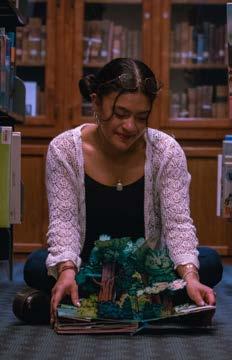
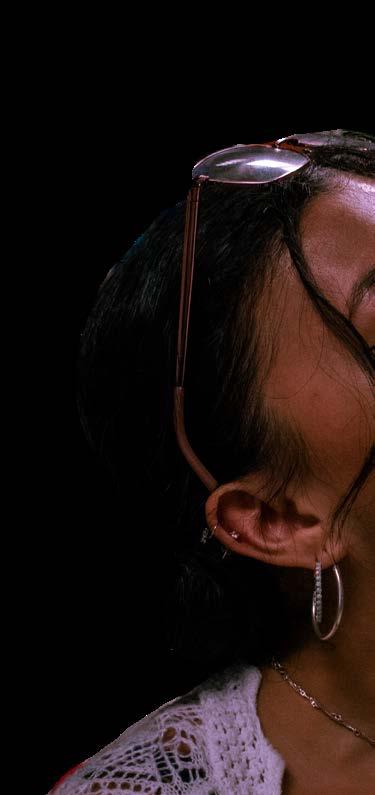
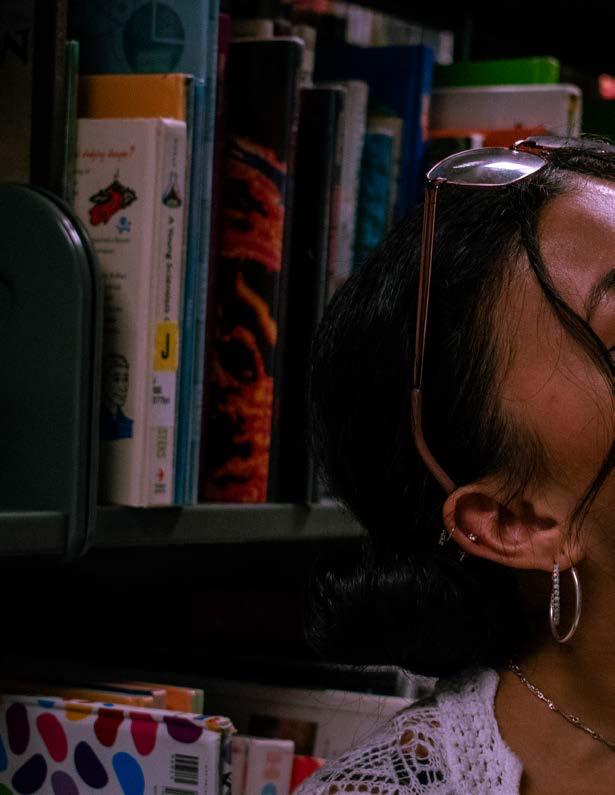

 PHOTO | DANE WETZEL
DESIGN | CLARA TRUEBNER
PHOTO | DANE WETZEL
DESIGN | CLARA TRUEBNER
There is no doubt that libraries have long been a source of solace and serenity; they are one of the most exemplary examples of such sanctuaries. Within the hushed aisles and cozy nooks of a library, individuals find refuge from the chaos of daily life, surrounded by the timeless wisdom and enchanting tales that line the shelves. Here, amidst the scent of old books and the soft rustle of turning pages, one can immerse oneself in the boundless realms of literature, escaping to distant lands and bygone eras with each flip of a page.
Within the library’s comforting embrace, the allure of childhood favorites offers a unique form of solace against life’s constant trials. Revisiting cherished books from our youth like Harry Potter, Percy Jackson & the Olympians, Diary of a Wimpy Kid, and more transport us to familiar worlds of wonder and whimsy while providing a powerful healthy coping mechanism in times of stress and uncertainty. The

timeless lessons and comforting familiarity found within the pages of childhood classics serve as a source of strength and resilience, offering guidance and reassurance when faced with adversity. In the embrace of a well-worn storybook, readers find not only an escape from the harsh realities of the world but also a gentle reminder of the enduring power of hope, courage, and perseverance.
The essence of this comforting haven allows us to delve into the magical world of children’s literature. Against the towering bookshelves and sunlit reading spaces within Belk Library, students can revisit beloved stories from their youth. Joy and nostalgia are immortalized within the stories from our youth, serving as a powerful reminder of the enduring power of storytelling to transport us back to simpler times and reignite the spark of imagination within us all.
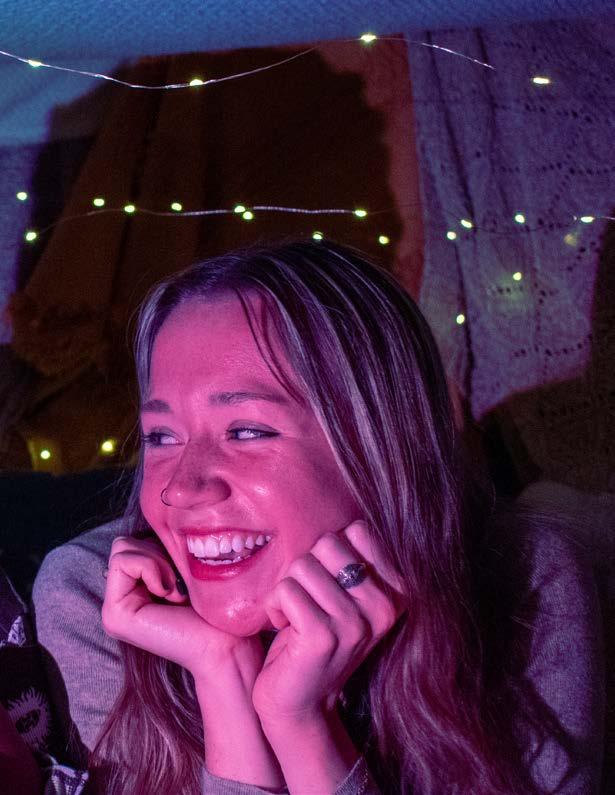


Imagine you are strolling through the aisles of a grocery store with a bulky plastic shopping cart on your weekly trip. As you turn the corner into the pasta section, there are two strangers side-by-side –taking up the entire width of the aisle. “Excuse me, I’m sorry,” you say so the other shoppers will move to give you space.
In this situation, you did nothing wrong by asking for space. Yet, you accepted the blame by apologizing.
If this sounds all too familiar, you are not alone. According to a survey carried out by research firm YouGov in April 2023, a quarter of Americans (24%) reported they apologize for things outside of their control at least daily. Further, 11% said they do this several times per day.
Over-apologizing is a common habit that can stem from a multitude of different places – each specific to a person’s lived experiences. Licensed marriage, family therapist and author of The Origins of You Vienna Pharaon told The Zoe Report in March 2023 that this is a learned behavior often tied to past experiences.

“For example, if you got validation, love, or attention in your family if you successfully pleased those around you, you may have learned that staying quiet or agreeing with others was what you needed to do,” Pharaon said. “Or maybe you learned that if you spoke up or had an alternative opinion it would turn into conflict, so you have chosen to keep the peace by apologizing.”
As children, we learn how to interact with others by observing our parents and the social dynamics that play out in our households. If we learned that unnecessary apologies worked, our subconscious picked up on that. Over extended periods this can have detrimental impacts on our self-esteem.
"Girls are told they must be confident, but not conceited. Be smart, but no one likes a know-it-all.
Ambition is good, but trying too hard is bad. Be assertive, but only if it doesn’t upset anyone else."

Dr. Stephan Hinshaw
Another important external influence contributing to this habit is the standards society has set regarding emotional ownership. Licensed trauma therapist and author of Why Am I Like This?: How to Break Cycles, Heal From Trauma, and Restore Your Faith Kobe Campbell told The Zoe Project in March 2023 that we are socialized to think others will only accept us based on how polite or compliant we are. In addition to this, it is commonly believed women over-apologize more than men do due to differing gender roles. The Child Mind Institute referenced the changing standards noted by Dr. Stephen Hinshaw in his book The Triple Mind.

Dr. Hinshaw wrote: Girls are told they must be confident, but not conceited. Be smart, but no one likes a know-it-all. Ambition is good, but trying too hard is bad. Be assertive, but only if it doesn’t upset anyone else. On the other hand, he added boys are often praised for their direct and confident behaviors.
Now, how can the often instinctual habit of over-apologizing be changed to a healthier approach? Director of Oasis Counseling Center, Inc. in Burlington, N.C. Karen Canada highlighted a few key steps when trying to alter a certain behavior. “The first step in any behavior is aware-
MODELS | EMMA PETROSINO, MAKENZIE PRIDGEN, JANEETA SMITH, LEXIE HOFFMANness – self-awareness, the awareness that I’m engaging in this behavior,” Canada said. A few key questions to aid in your overall understanding of your apologizing habits are “Who am I over-apologizing with?” “When am I over-apologizing?” “What is motivating me to over-apologize?” Next, Canada said to set an intention for yourself.
This could be as simple as “I intend to try and catch myself each time I apologize for something that is not my fault,” or it could look something like “I intend to go to therapy to better understand my feelings.” Understanding your personal needs is vital when it

comes to setting a reasonable goal for yourself. After this, finding supportive outlets that will also hold you accountable is helpful because attempting to change a deeply ingrained pattern of behavior is more challenging alone, Canada added. She continued to say the closing piece of this healing journey is learning “distress tolerance,” or how to sit with the anxiety of the space between the apology and the response.
“For anyone who is trying to change a behavior, adopt an approach of self-compassion – being gentle and kind to yourself about the process of change,” Canada said. “The process of change is not linear.”

Typically, being told you “dress like a grandma” would not be considered high praise. When considering our grandparents’ closets, our minds don’t automatically think of words like “sexy,” “trendy” and “youthful.” Instead, we think “practical,” “comfortable” and “traditional.” However, a new wave of fashion trends has caused many to reevaluate how they think about their elders (and their respective closets). As trends like ‘coastal grandmother’ and ‘eclectic grandpa’ pop up, we’ve given ourselves permission to have full reign of the grandparent aesthetic and everything it has to offer, which subsequently has opened our eyes to fashion trends of the past and how closely our ancestors’ closets resemble our own.
In the ever-changing world of fashion, some looks are considered timeless. These outfits are labeled as “never going out of style” due to their ability to stand the test of time even as trends pass. A classic example of timeless fashion is the little black dress, or ‘LBD’ to her friends. This is a staple piece for any closet and has

remained prevalent on the fashion scene for decades. However, there are a plethora of other fashion trends that may not be considered “timeless,” but pay homage to fashion choices of the past while still having a modern flair.
One of the most iconic times in fashion history was the Victorian Era. Although many of the trends from this time period are long gone, like elbow-length gloves and bonnets, a few articles have managed to slip through the cracks of time, including the corset. The first evidence of corsets comes from a Cretian tomb from 1000 BC, where it was made of linen and wool and likely only used for ceremonial purposes. However, this item became a staple in the 16th century when it was introduced to the French Court by Catherine de Medici.
The lace-up corset only continued to grow in popularity as time went on, however, its design and shape have changed dramatically while lace-up corsets are still worn by some, their purpose has transitioned away from giving women impossibly tiny waists and towards func-






 MODELS | CATIE MANNATO, JO ANNE WRIGHT, PAT UMBAUGH
MODELS | CATIE MANNATO, JO ANNE WRIGHT, PAT UMBAUGH
ctionality and fun. This blast-from-the-past clothing item can now be seen across the 21st century as young women have changed it from formal wear to party wear. While these corsets are still created with underwiring and bonecasing, the modern-day version is much more breathable and less time-consuming to put on. Many of these corsets, or bustiers, are cropped and can be fastened with a simple hook and eye closure, similar to what you’d find on a bra. You won’t find these tops in a Bridgerton ballroom, but you may see a few at your local bar.
The modern coquette fashion trend is also widely inspired by the Victorian era. The “coquette” aesthetic is mainly characterized by bows, frills, and all things pink and feminine. Yet again, we see the modernization of Victorian fashion. Large hoop skirts have evolved to simpler long flowy skirts that can be worn daily, not just on formal occasions. Elaborate bows and ruffles are now dainty hair accessories and subtle lace. We’ve also seen Victorian fashion pop up within the last few decades,
such as the once-popular puffed sleeve trend.
As we move forward in time, there are endless more past-fashion trends that appear in our modern-day wardrobes. The denim craze we see in today’s magazines isn’t far from the denim our parents and grandparents donned in the 70s and 80s. While they obsessed over boot-cut jeans and denim jackets, we rave over wide-leg pants and denim jumpsuits. Their feathered blown-out hair dos aren’t that different from the DIY blowouts many create using heated round brushes and hair-dryer brushes. It was only a few years ago that long denim skirts were considered old-fashioned but are now being
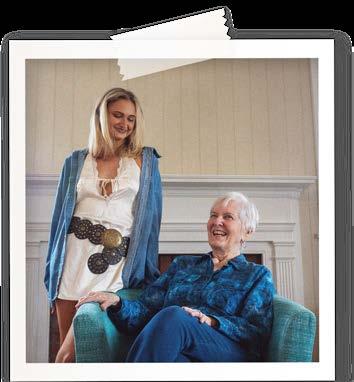 PHOTO | DECLAN MCGEADY DESIGN | CHRISSY YEAGER
PHOTO | DECLAN MCGEADY DESIGN | CHRISSY YEAGER



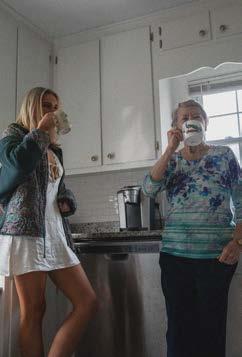


As we explore past fashion, it’s easy to laugh at some of the pieces things people used to wear (hello legwarers! While we may not wear those exact items today, if you look closely enough you’ll begin to notice the subtle nods that our fashion choices give to different peri ods. One of the beautiful things about time is how a narrative can change. What once was considered to be old-fashioned and out of style can come back around again and again in unexpected, modern ways. The next time you visit your grandparents, ask to take a peek into their closets.You may find more trendy items than you thought. And, as Macklemore says, “I’ll wear your granddad’s clothes. I’ll look incredible.”





 FEMMA PETROSINO
FEMMA PETROSINO
amily ties are like an intricate, complex knot - and that knot is wound pretty tightly when you’re younger. For the first 18 years of your life, you have likely been confined to familiar surroundings and seen the same faces day in and day out. Your parents, siblings, and perhaps a few other family members, comprised the majority of your world - shaping your beliefs, values, and outlook on life.
The ties between you and your parents extend far beyond genetic inheritance. While you may have inherited your mom’s blue eyes or your dad’s distinctive nose- their influence doesn’t just stop there. Your parents have likely impacted countless aspects of your life, from your food preferences, to how you treat other people, to your political views, and everything in between. Whether consciously or unconsciously, these influences become ingrained into your being.
But the person you are when you go to college will not be the same person you are when you return home.
College gives young adults the opportunity to forge their own path - unweaving the knots of family ties.
As a freshman, transitioning from the familiarity of family life to the autonomy of college can be daunting, as you learn to navigate life without constant supervision. Throughout this year, you embrace independence, making your own choices and managing your responsibilities - everything from choosing your own classes, to making sure you build enough time into your day to study and have some down time, to learning the quickest way to get to class. It is a year of self-discovery where you begin to learn to navigate the world on your own and explore new interests you may have never considered before attending college. You learn new skills and create a routine that couldn’t be any different than your life before - now that your life is completely up to you.
As you interact with people from diverse backgrounds, you are exposed to new ideas, cultures,






and experiences that help you to grow and challenge preconceived notions. You try avocado toast for the first time, you may celebrate Passover with your roommate, you might try a dance class, or even study abroad in a whole new country. Through the different connections you make each day, you begin to identify your place in the world beyond your family members. Your roommates, friends, classmates, professors, friends of friends, all add a new dimension to your life and family ties start to loosen.
Along with all these new experiences also come challenges. Now, instead of the familiarity of your mom wiping your tears or your dad giving you a back rub after a hard day, you need to find your own sources of comfort. The first time you get sick, you still call your mom, but you have to get yourself to the doctor, speak up for yourself and pick up your own prescription. If you and your roommate have different sleep schedules or study habits, you need to figure out how to resolve these issues on your own. You become resilient. College allows for a deeper exploration of the
influences that have shaped your identity and perspectives. Here, you peel back the layers of your upbringing, revealing insights into the aspects of family life that have contributed to the person you are today. For example, your parents may have always wanted you to be a doctor, but you decide to become an actor instead. There’s no right or wrong. Embracing new perspectives in the college environment enables you to reassess and refine these influences, while still incorporating valuable lessons learned from the past.
Every little piece of your experience at college contributes to your personal growth. The fact of the matter is, most people grow up to think their future will be a certain way due to their upbringing and expectations set by family members. While the bonds of family may remain a cherished part of one’s life, college is about finding your own identity. The world is your own, not what others make it out to be- that is the power of untying yourself from the knot. ■
The world is your own,
not what others make it out to be





Since the dawn of television, stars have been gracing the screen with new and daring fashion. From Bowie to Prince to Janelle Monae, celebrities have often been the trend-setters in the fashion industry, and have fought to blur the lines between men and women’s fashion. The digital age has dominated fashion, bringing it to the forefront faster than ever before. We at The Edge believe in diving back into the past and finding some of the looks that created gender-neutral fashion as we know it today. The fashion industry has been exploring gender neutrality for centuries, but it didn’t start breaking into the mainstream until the 1970s Rockstar Revolution when stars like Bowie, Hendrix and Jagger changed what men’s fashion was supposed to look like, and how masculinity can look however they want it to. Bowie debuted the iconic Star Man makeup and Ziggy Stardust alter ego, making public appearances in polka-dot scarves, sparkly dresses and lightning bolt makeup. Seeing a major rock star play shows in elaborate makeup and daring costumes sent the idea of androgynous fashion forward, showcasing the ways that silhouettes and styles that were commonly worn by women could be reimagined in a way that appealed to everyone and pushed the envelope. The 80s brought androgyny to the forefront in a new way, with stars like Prince and Grace Jones wearing styles even more daring than the ones before them. Prince paired masculine styles with feminine and launched the idea of blurring the lines, wearing silk suits and heeled go-go boots, balancing traditionally male silhouettes with feminine touches, and the public loved it. Grace Jones had her flattop haircut, built frame and sharp features, showcasing how women could use their natural features to make a statement in androgyny. She became one of the first mainstream women to embody gender neutrality at its core, and expressed that both sides can make a statement and protect her power. In her memoir, Jones spoke about her appearance, saying, “I have a very strong male side, which I developed to protect my female side. If I want a diamond necklace, I can go and buy myself a diamond necklace”.
















The ‘90s and the turn of the century created a new idea of androgyny: Grunge. Kurt Cobain became the poster child for grunge androgyny, being featured in magazines and headlining shows in floral dresses, eyeliner, and his iconic long blonde hair. Cobain used androgyny as a way to question social norms and what men’s fashion was. In an interview with The Atlantic, Cobain said, “Using clothes to play with gender in this way isn’t just about looking pretty: It’s highlighting the edges of society, celebrating outsiders and questioning norms.” Women were also experimenting with fashion norms in the grunge era, donning their iconic flannels, new short haircuts and Dr. Martens boots, which had previously been used exclusively for men. Women no longer wanted to be defined by their sex appeal, and fashion became a
 ONODA, ZOE PIGHET, OWEN HOWELL
ONODA, ZOE PIGHET, OWEN HOWELL

In the current age of social media, fashion has changed, warped and adapted into something no longer bound by gender. Celebs like Kristen Stewart, Harry Styles, and Janelle Monae often play around with their looks, creating iconic ensembles that everyone can recognize, like Styles’ iconic dress look on the cover of Vogue, Stewart’s Chanel pantsuit at the 2021 Met Gala, and Monae’s red take on a traditional suit with a feminine touch at the 2018 Vanity Fair Oscars Party. All of these celebrities have their own personal take on blurring the lines: women wearing suits to traditional gown events, and men adding capes, color and jewelry to change up the traditional tuxedo. Social media has turned fashion on its head, showcasing how daring and androgynous looks can become the highlight of a red carpet.
Everyday people are also becoming more androgynous in fashion as well. Subcultures like the Goth or Grunge communities are switching up styles, men are experimenting with high waistlines, long skirts and cropped tees, and women’s clothes are getting baggier and boxier, with denim being wide-legged, and hoodies being 3 sizes too big. Makeup and hairstyles are changing, with more women going for short, boyish styles, and men embracing the longer locks. Makeup brands like e.l.f. are making an entire line of makeup marketed toward men, and nail polish making its way into the mainstream for everyone.
What began as a form of shock, resistance and social defiance, androgyny has always been a way to change up what should be. There is always something new coming out of the fashion world, and television, film and social media have become a way to fast-track trends into the mainstream. Wearing whatever you like is the lesson to learn, and men’s and women’s clothing have always been a construct. Changing the narrative takes work, and the more people there are working toward that new idea of normal, the more gendered clothing may become a thing of the past.

Nowadays, people take more photos than ever before, yet value them less. We snap a photo of anything and everything — not to mention retaking the same photos countless times — quickly racking up a camera roll with over 10 thousand photos. The obsession to capture everything has made pictures less meaningful.
Scrapbooking is a much more memorable way to capture and remember these valuable moments. During the generations of our parents and grandparents, they couldn’t just “keep clicking” like we do today. They had one chance to take one picture to cherish forever. While this may seem unfortunate and like a disadvantage in the eyes of those who have grown up with the luxury of cell phones, it makes the photos all the more special.
The most beautiful way to learn about your parents, grandparents and even great-grandparents’ lives is by looking through their preserved photo albums and scrapbooks. Scrapbooking dates back to the 15th century, originating with the purpose of people ‘saving their scraps.’ Through and through, it’s been the perfect way to preserve family history and major moments. The joy of flipping through loved ones’ scrapbooks to learn more about their lives, accomplishments, and favorite moments is priceless and something you can’t get
scrolling through your phone’s camera roll. Passing down stories and memories through generations of our families connects us. The art of storytelling through scrapbooking shouldn’t be left in the past, but instead should live on and be passed down to the generations to come.
It’s clear that scrapbooking is meaningful, but it can be a fun activity as well! You have complete creative control to make it as vibrant or minimal as possible. It’s a good way to remember your proudest accomplishments, study abroad and travel experiences, and anything important to you. One of the best ways to scrapbook is to do it with someone you love! Whether you’re creating a scrapbook as a family and documenting a family vacation, or with your best friend to document summer break, it’s a bonding experience meant to capture memories.
You can reminisce, share stories and get reminded of memories that may have slipped your mind over the years. Engaging in this creative activity can release endorphins and overall positively impact your mental health. Using creative skills without limitation in a craft like scrapbooking is known to ignite feelings of happiness and satisfaction.

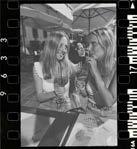




Scrapbooking has been proven to be a great stress reliever: “The act of performing a craft is incompatible with worry, anger, obsession, and anxiety. Crafts make you concentrate on the here and now and distract you from everyday pressures and problems,” said New York University psychologist Robert Reiner, Ph.D. But, it is important to mention that scrapbooking can bring up lots of feelings and emotions. People can scrapbook about the good and the bad, and it can be a helpful emotional outlet. Because of this, it is a tool often used in therapy. It brings up feelings of nostalgia and even allows people to creatively communicate things they aren’t able to articulate with words.
Another benefit of scrapbooking is that it can help you see the joy in life. With mental health being such a prevalent topic these days, and the rise of anxiety and depression in college students, any outlet that




“Looking through old photos and reminiscing of emotional benefits appreciation for life






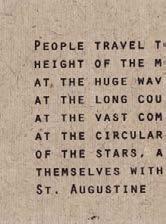


reminiscing on memories has plenty benefits that can provide a deeper life and its experiences. ”

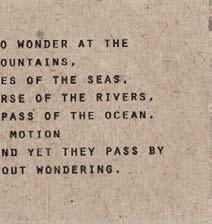













Scrapbooking is a form of art, like painting and drawing, where you truly have complete artistic freedom. Many people find that the best way to express themselves is through art. But even for those who don’t consider themselves artistic, scrapbooking provides this sense of creative self-expression that you can’t necessarily find in other places.
Of course, there are ways to digitally scrapbook an occasion. Most popularly for documenting a family vacation or reunion, these books can make the memorypreserving process easier. It’s still a memorable way to keep photographs, and it looks considerably nice and professional done that way. It’s an easy way to create something you can have multiple copies of to give to other family members! Shutterfly has constant deals on different-sized books with varieties of features.











For college students—or anyone looking to scrapbook on a budget—there are many ways to do so! CVS and Walgreens offer relatively inexpensive photo printing services. Supplies including markers, pens, cutouts, and stickers can be easily found at Target or Michaels. And, to save more money, you can create your own cutouts using construction paper from anywhere. It’s a simple way to spice up your scrapbooking experience, while not spending too much money!
Generally speaking, scrapbooking is a positive way to connect to the generations before and after us. It allows us to look back on what we’ve achieved and see how far we’ve come, as well as set goals for ourselves. Scrapbooking is a great way to see how much you’ve grown and determine what you aspire to be or accomplish in your future.
So if the countless positive benefits have influenced you… scrapbook away! Preserve your most treasured memories so future generations to come will understand the importance of tangible memories, rather than scrolling through your iPhone.






Just roll the dice!” is a term that’s used to tell someone to take a chance — or to tell your friend it’s their turn during a heated game of Monopoly. Take a chance, go outside your comfort zone and invite change into your life. Sometimes it can be so nerve-wracking that we want to go back to playing Monopoly with pretend money and problems that we can leave behind when we walk away from the board (unless you have Monopoly drama like my family). Taking risks and having faith can be challenging, but with no risk comes no reward… right?
Change is some people’s greatest fear. We may find ourselves so comfortable with how things are right now that the excitement of what could be a new beginning can get muddled with the pessimistic what-ifs. Change is inevitable, it isn’t going anywhere. You can’t count on a lot of things in this world for certain, but you can always count on change to keep your life consistently inconsistent. The sooner we learn to embrace change, the sooner we can uncover all of the life lessons it offers.
Change isn’t the enemy. It can be the blessing in disguise, the push you need or the reminder to tell the people you love that you love them more often. Change can be hope, faith or gratitude — it simply depends on how we frame our mindset. We can’t always control what in our life changes, but we can try to control how we react to it. As I’ve been finishing my third year here at Elon, life after graduation has been on my mind more than ever. Getting ready for the uncharted territory of “real life” is both exciting and
intimidating. I remind myself that I can’t control what will happen post-graduation, but I can control what I do with my remaining time at Elon. To feel inspired to make the most of my remaining time at Elon, I need to maintain a positive headspace. The most effective way for me to do that is to get out of my head and be present in my body. A strong foundation today will allow me to accomplish tomorrow.
I don’t care who you are, we have all had a low point in our lives. Everyone’s will look different, but low is still low. Maybe you’re at your lowest point right now or maybe it was so long ago that you can hardly remember what it was like because things changed. Remember Monopoly?
Even if you didn’t have the get-out-of-jail-free card or landed on doubles, you still got out of jail after your third turn. Things will change for the better.
Sometimes we need to be patient. It can be difficult to remain positive and hopeful when we’re hit with the unexpected and things might change for the worse again before they start to get better. Remember that change is not going anywhere and your turn will be soon too.
Part of truly living life is experiencing all the big emotions. The trade-off we have as human beings is that we get to experience feelings of joy, excitement and love, but that also comes with the not-so-appealing feelings of sadness, envy and loss. The next time I swim in an ocean I’m going to shout “This is living!!!” and the next time I’m crying in my bed I’m going to whisper “This is living.” Both hold different meanings and life lessons, but both are important.
“This is living!!!” definitely feels better in the moment. It reminds us to be grateful for the present and our current state of happiness. But the sadly whispered “This is living.” can come with a greater lesson or spark a new way of thinking. We often learn the most after overcoming difficult times.
You may be reading this right now wishing nothing in your life would change and that’s great — enjoy these moments. But I’m sure we have all experienced a time when we thought everything in our lives was running smoothly and as planned until things suddenly completely shifted. Although the time right after that change can feel daunting, stressful and unknown, we all got through it and we will get through it. Things will change again.
Imagine living life every day knowing that everything would stay the same, with no worries about something unfortunate or unexpected happening. It may sound nice at first, but, after some point, we would most likely become desensitized to everything life is. Playing a board game and rolling the same number every time, knowing that you’ll win would probably be the most boring game to exist. Knowing we could lose makes winning that much more exciting. Without times of difficulties or unexpected shifts, we wouldn’t be able to feel as much gratitude when good times are happening and there would be no balance. Accepting change into your life may temporarily disrupt your peace, but it will
result in more heightened “This is living!!!” feelings that you will appreciate much more. Living a full life means experiencing life’s highs, lows and all of the inevitable changes that come with day-to-day life. Remember that no matter what, we cannot expect anything, meaning we shouldn’t take anything for granted. Coming to terms with the fact that anything can change in a minute can be liberating because it helps us to be grateful for everything we have — and gratitude is the key to happiness. There’s nothing wrong with working towards making positive changes in your life and sometimes, we’ll wish for things to be different, but try not to lose sight of the gift of today.
Knowing that change affects everyone can bring a feeling of comfort when we feel alone, plus it’s a reminder to have compassion. Everyone deals with and reacts to experiences in a way unique to them. We can never quite be sure what the person next to us is going through. We are all living our lives for the first time and trying our best to navigate the changes we face.
Change is a constant reminder that we’re living life. As much as we love the unstoppable high moments, we can’t feel those without spending time with our lows. Embrace change as something to grow, evolve and learn from. Keep feeling all of life’s big emotions and everything in between; have the courage to keep rolling the dice.
“Just
